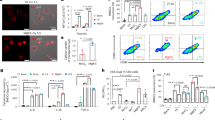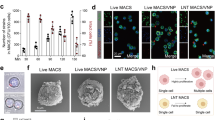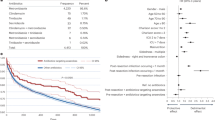Abstract
Some anaerobic and facultative anaerobic bacteria have been used experimentally as anticancer agents because of their selective growth in the hypoxia regions of solid tumors after systemic administration. We have previously shown the feasibility of using attenuated Salmonella choleraesuis as a gene delivery vector. In this study, we exploited S. choleraesuis carrying thrombospondin-1 (TSP-1) gene for treating primary melanoma and experimental pulmonary metastasis in the syngeneic murine B16F10 melanoma model. Systemic administration of S. choleraesuis allowed targeted gene delivery to tumors. The bacteria accumulated preferentially in tumors over livers and spleens at ratios ranging from 1000:1 to 10,000:1. The level of transgene expression via S. choleraesuis-mediated gene transfer in tumors could reach more than 1800-fold higher than in livers and spleens. Notably, bacterial accumulation was also observed in the lungs with metastatic nodules, but not in healthy lungs. When administered into mice bearing subcutaneous or pulmonary metastatic melanomas, S. choleraesuis carrying TSP-1 gene significantly inhibited tumor growth and enhanced survival of the mice. Immunohistochemical studies in the tumors from these mice displayed decreased intratumoral microvessel density. Taken together, these findings suggest that TSP-1 gene therapy delivered by S. choleraesuis may be effective for the treatment of primary as well as metastatic melanomas.
This is a preview of subscription content, access via your institution
Access options
Subscribe to this journal
Receive 12 print issues and online access
$259.00 per year
only $21.58 per issue
Buy this article
- Purchase on Springer Link
- Instant access to full article PDF
Prices may be subject to local taxes which are calculated during checkout






Similar content being viewed by others
References
Pawelek JM, Low KB, Bermudes D . Tumor-targeted Salmonella as a novel anticancer vector. Cancer Res. 1997;57:4537–4544.
Sznol M, Lin SL, Bermudes D, et al. Use of preferentially replicating bacteria for the treatment of cancer. J Clin Invest. 2000;105:1027–1030.
Pawelek JM, Low KB, Bermudes D . Bacteria as tumour-targeting vectors. Lancet Oncol. 2003;4:548–556.
Lemmon MJ, van Zijl P, Fox ME, et al. Anaerobic bacteria as a gene delivery system that is controlled by the tumor microenvironment. Gene Therapy. 1997;4:791–796.
Theys J, Landuyt W, Nuyts S, et al. Specific targeting of cytosine deaminase to solid tumors by engineered Clostridium acetobutylicum. Cancer Gene Ther. 2001;8:294–297.
Dang LH, Bettegowda C, Huso DL, et al. Combination bacteriolytic therapy for the treatment of experimental tumors. Proc Natl Acad Sci USA. 2001;98:15155–15160.
Yazawa K, Fujimori M, Amano J, et al. Bifidobacterium longum as a delivery system for cancer gene therapy: selective localization and growth in hypoxic tumors. Cancer Gene Ther. 2000;7:269–274.
Li X, Fu GF, Fan YR, et al. Bifidobacterium adolescentis as a delivery system of endostatin for cancer gene therapy: selective inhibitor of angiogenesis and hypoxic tumor growth. Cancer Gene Ther. 2003;10:105–111.
Low KB, Ittensohn M, Le T, et al. Lipid A mutant Salmonella with suppressed virulence and TNF-α induction retain tumor-targeting in vivo. Nat Biotechnol. 1999;17:37–41.
King I, Bermudes D, Lin S, et al. Tumor-targeted Salmonella expressing cytosine deaminase as an anticancer agent. Hum Gene Ther. 2002;13:1225–1233.
Nuyts S, Van Mellaert L, Theys J, et al. Radio-responsive recA promoter significantly increases TNF-α production in recombinant clostridia after 2 Gy irradiation. Gene Therapy. 2001;8:1197–1201.
Hartmann A, Kunz M, Kostlin S, et al. Hypoxia-induced up-regulation of angiogenin in human malignant melanoma. Cancer Res. 1999;59:1578–1583.
Neitzel LT, Neitzel CD, Magee KL, Malafa MP . Angiogenesis correlates with metastasis in melanoma. Ann Surg Oncol. 1999;6:70–74.
Streit M, Detmar M . Angiogenesis, lymphangiogenesis, and melanoma metastasis. Oncogene. 2003;22:3172–3179.
Miao WM, Seng WL, Duquette M, Lawler P, Laus C, Lawler J . Thrombospondin-1 type 1 repeat recombinant proteins inhibit tumor growth through transforming growth factor-β-dependent and -independent mechanisms. Cancer Res. 2001;61:7830–7839.
Volpert OV, Lawler J, Bouck NP . A human fibrosarcoma inhibits systemic angiogenesis and the growth of experimental metastases via thrombospondin-1. Proc Natl Acad Sci USA. 1998;95:6343–6348.
Shiau AL, Chen YL, Liao CY, Huang YS, Wu CL . Prothymosin α enhances protective immune responses induced by oral DNA vaccination against pseudorabies delivered by Salmonella choleraesuis. Vaccine. 2001;19:3947–3956.
Lee CH, Wu CL, Shiau AL . Endostatin gene therapy delivered by Salmonella choleraesuis in murine tumor models. J Gene Med. in press.
Ades EW, Candal FJ, Swerlick RA, et al. HMEC-1: establishment of an immortalized human microvascular endothelial cell line. J Invest Dermatol. 1992;99:683–690.
Weidner N, Semple JP, Welch WR, Folkman J . Tumor angiogenesis and metastasis—correlation in invasive breast carcinoma. N Engl J Med. 1991;324:1–8.
Weiss S, Chakraborty T . Transfer of eukaryotic expression plasmids to mammalian host cells by bacterial carriers. Curr Opin Biotechnol. 2001;12:467–472.
Critchley RJ, Jezzard S, Radford KJ, et al. Potential therapeutic applications of recombinant, invasive E. coli. Gene Therapy. 2004;11:1224–1233.
Grillot-Courvalin C, Goussard S, Courvalin P . Wild-type intracellular bacteria deliver DNA into mammalian cells. Cell Microbiol. 2002;4:177–186.
Bannerman DD, Tupper JC, Ricketts WA, Bennett CF, Winn RK, Harlan JM . A constitutive cytoprotective pathway protects endothelial cells from lipopolysaccharide-induced apoptosis. J Biol Chem. 2001;276:14924–14932.
Dkhissi F, Lu H, Soria C, et al. Endostatin exhibits a direct antitumor effect in addition to its antiangiogenic activity in colon cancer cells. Hum Gene Ther. 2003;14:997–1008.
Kisker O, Becker CM, Prox D, et al. Continuous administration of endostatin by intraperitoneally implanted osmotic pump improves the efficacy and potency of therapy in a mouse xenograft tumor model. Cancer Res. 2001;61:7669–7674.
Beecken WD, Fernandez A, Joussen AM, et al. Effect of antiangiogenic therapy on slowly growing, poorly vascularized tumors in mice. J Natl Cancer Inst. 2001;93:382–387.
Bergers G, Javaherian K, Lo KM, Folkman J, Hanahan D . Effects of angiogenesis inhibitors on multistage carcinogenesis in mice. Science. 1999;284:808–812.
Herlyn M, Clark WH, Rodeck U, Mancianti ML, Jambrosic J, Koprowski H . Biology of tumor progression in human melanocytes. Lab Invest. 1987;56:461–474.
Straume O, Salvesen HB, Akslen LA . Angiogenesis is prognostically important in vertical growth phase melanomas. Int J Oncol. 1999;15:595–599.
Rodeck U, Becker D, Herlyn M . Basic fibroblast growth factor in human melanoma. Cancer Cells. 1991;3:308–311.
Potgens AJ, Lubsen NH, van Altena MC, Schoenmakers JG, Ruiter DJ, de Waal RM . Vascular permeability factor expression influences tumor angiogenesis in human melanoma lines xenografted to nude mice. Am J Pathol. 1995;146:197–209.
Theys J, Landuyt W, Nuyts S, et al. Improvement of Clostridium tumour targeting vectors evaluated in rat rhabdomyosarcomas. FEMS Immunol Med Microbiol. 2001;30:37–41.
Bleuel K, Popp S, Fusenig NE, Stanbridge EJ, Boukamp P . Tumor suppression in human skin carcinoma cells by chromosome 15 transfer or thrombospondin-1 overexpression through halted tumor vascularization. Proc Natl Acad Sci USA. 1999;96:2065–2070.
Streit M, Velasco P, Brown LF, et al. Overexpression of thrombospondin-1 decreases angiogenesis and inhibits the growth of human cutaneous squamous cell carcinomas. Am J Pathol. 1999;155:441–452.
Lawler J . The functions of thrombospondin-1 and 2. Curr Opin Cell Biol. 2000;12:634–640.
Bein K, Simons M . Thrombospondin type 1 repeats interact with matrix metalloproteinase 2. Regulation of metalloproteinase activity. J Biol Chem. 2000;275:32167–32173.
Rodriguez-Manzaneque JC, Lane TF, Ortega MA, Hynes RO, Lawler J, Iruela-Arispe ML . Thrombospondin-1 suppresses spontaneous tumor growth and inhibits activation of matrix metalloproteinase-9 and mobilization of vascular endothelial growth factor. Proc Natl Acad Sci USA. 2001;98:12485–12490.
Taraboletti G, Morbidelli L, Donnini S, et al. The heparin binding 25 kDa fragment of thrombospondin-1 promotes angiogenesis and modulates gelatinase and TIMP-2 production in endothelial cells. FASEB J. 2000;14:1674–1676.
Lawler J, Miao WM, Duquette M, Bouck N, Bronson RT, Hynes RO . Thrombospondin-1 gene expression affects survival and tumor spectrum of p53-deficient mice. Am J Pathol. 2001;159:1949–1956.
Guo Y, Kyprianou N . Restoration of transforming growth factor-β signaling pathway in human prostate cancer cells suppresses tumorigenicity via induction of caspase-1-mediated apoptosis. Cancer Res. 1999;59:1366–1371.
Twardzik DR, Ranchalis JE, McPherson JM, et al. Inhibition and promotion of differentiated-like phenotype of a human lung carcinoma in athymic mice by natural and recombinant forms of transforming growth factor-β. J Natl Cancer Inst. 1989;81:1182–1185.
Acknowledgements
This work was supported by Grants (NSC 91-3112-B-006-013 and NSC 92-3112-B-006-007) from the National Science Council, Taiwan.
Author information
Authors and Affiliations
Corresponding author
Rights and permissions
About this article
Cite this article
Lee, CH., Wu, CL. & Shiau, AL. Systemic administration of attenuated Salmonella choleraesuis carrying thrombospondin-1 gene leads to tumor-specific transgene expression, delayed tumor growth and prolonged survival in the murine melanoma model. Cancer Gene Ther 12, 175–184 (2005). https://doi.org/10.1038/sj.cgt.7700777
Received:
Published:
Issue Date:
DOI: https://doi.org/10.1038/sj.cgt.7700777
Keywords
This article is cited by
-
Engineering the gut microbiota to treat chronic diseases
Applied Microbiology and Biotechnology (2020)
-
Increasing the bactofection capacity of a mammalian expression vector by removal of the f1 ori
Cancer Gene Therapy (2019)
-
Tumour-targeting bacteria engineered to fight cancer
Nature Reviews Cancer (2018)
-
Engineering Salmonella as intracellular factory for effective killing of tumour cells
Scientific Reports (2016)
-
Engineering of bacterial strains and their products for cancer therapy
Applied Microbiology and Biotechnology (2013)



